Menus
- Green cheerfulness
- Leader of the Sport-GT segment in Europe, the Z 1000 SX refines its version in 2014
- Introduction
- In the saddle
- In the city
- Motorway and expressways
- Departmental
- Duo
- Consumption
- Accessories
- Conclusion
Green cheerfulness
Leader of the Sport-GT segment in Europe, the Z 1000 SX refines its version in 2014
This second generation of Z 1000 SX is gaining in maturity without departing from the fun side that made the charm of the 2010 model: improved engine response, revised suspensions, driving aids

Introduction
Appearing in late 2010 on the Sport-GT market, the Z 1000 SX was already exploding in a segment where seriousness and the art of compromise reigned supreme. Admittedly, this GTized roadster sinned by aptitudes for the duo and long journeys behind the competition, but put forward sporting skills and a refreshing fun side. We have to believe that the formula has seduced since the Z 1000 SX is now the leader in its segment in Europe and alone accounts for 25% of sales. Surprising ?
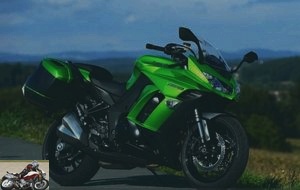
The problem with this kind of machine is to adjust the proportion of Sport and the proportion of GT according to the needs and desires of the market. In 2010, Kawasaki knew that the following year would be unveiled its big trail Versys 1000 with the same engine as the SX. Hence the deliberately "medium haul" orientation of the SX. It is no coincidence that one of the main changes to the 2014 vintage is new luggage storage space reduced from 35 to 28 liters !
The argument put forward by Kawasaki is that the new side cases (still optional) fit better into the lines of the machine, make it easier to climb up lines and can still contain a full face helmet each. Also for aesthetic reasons, the new mounting system is invisible once the cases have been removed. And as on the 2010 version, you have to choose between side cases OR top-case, impossible to fit both at the same time…. Be careful, this 2014 version is not meant to be more radical because the rear shock absorber has a new offset adjustment wheel allowing the preload to be adjusted without removing the tool kit. By the way, Kawasaki has also revised the suspension of its SX with a harder rear spring and revised damping laws at the front and rear..
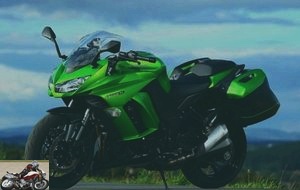
The rider’s seat is redesigned to provide a flatter seat.
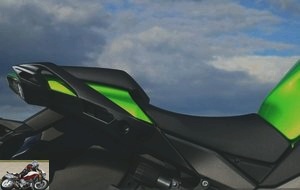
On the engine side, the in-line four-cylinder has been redesigned to improve its responsiveness, especially at low and medium speeds. Among the main modifications, we will note the adoption of a new intake camshaft with a less pointed profile, the standardization of the length of the intake trumpets (4 long against 2 long and two short previously) as well as a reconfigured injection and a new air filter. The exhaust is not to be outdone with a new manifold reducing back pressure at all revs. Finally, Kawasaki announces having lengthened the sixth gear to reduce consumption and noise level on the highway. And for music lovers, the air box has been modified: less noise at low revs and a little more in the second half of the tachometer…. Let’s not forget the driver assistance component with injection mapping that can be programmed in two modes: Full Power (138 hp) and Low Power (70% of the power and a smoother response to the accelerator). The Z 1000 SX also offers three-stage adjustable KTRC traction control. In mode 1 or 2, maximum acceleration is preferred (and even allows wheelies) while mode 3, more intrusive, is recommended when grip conditions are precarious. The most bleeding also have the option of completely disconnecting the system. The settings for both systems are displayed directly on the dashboard and can be controlled directly from the left half-handlebar. If necessary, the parameters can be changed while driving as long as you do not accelerate.
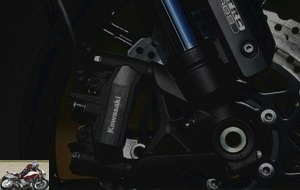
Braking radius, the radial calipers at the front are now one-piece, while the pads have a higher coefficient of friction. The ABS versions (still an option) inherit a new power plant with increased deceleration power. Aesthetically, the 2014 version is distinguished by mufflers that change from black to gray and new mirrors with spacing fixed to that of the side cases to ride with peace of mind in traffic jams…

In the saddle
No change when stepping over this new Z 1000 SX. The saddle, particularly thin at the junction with the tank, allows a 1.70 m rider to put both feet flat while the torso is lightly resting on the handles once the half-handlebars are in hand. In addition to the new electronic modes displayed on the instrument panel, an ECO warning light indicating “optimal” consumption has appeared. Personally, I would have traded it for a gear indicator engaged but the intention is commendable given the price of unleaded at the moment. An average and instantaneous consumption indicator and an estimate of the remaining battery life can be displayed in a corner of the LCD screen. We switch from one information to another with the same control unit used to set the driving aids. And if the overall aesthetic continues to be controversial, the overall finish is of an excellent level.
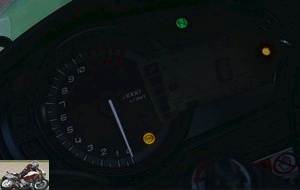
Cables, hoses and other wires are hidden from view, the good paintwork and the adjustments of the various body parts are more made in Japan than made in China. As our test machines are all equipped with the optional GIVI side cases, we were able to verify that their handling is childish. They are fixed using specific passenger handles, included in the kit, probably to prevent smart people ordering directly from the manufacturer without going through the dealership box….
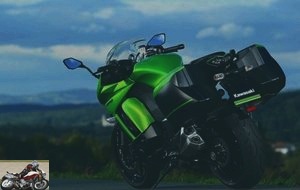
In the city
Without being a ballerina, the Z 1000 SX is reassuring in its evolution at low speed. Much of the 230 kilos evaporates as soon as the wheels turn. The feel on the handlebars is a machine with excellent mass centralization and a remarkably low center of gravity. The steering, neutral and progressive in the angle, inspires confidence and the hydraulics of the suspensions on the rare portions in poor condition proved to be flawless. As for the Kawasaki 4-cylinder, tested here in a free version – we are in Austria – it is still impressive in terms of smoothness and low torque. Able to resume in 6th at 30 km / h on idle, it distills a large part of its 11.3 mkg (9.7 mkg in the clamped version) from 3000 rpm. And there is no need to exceed 6,000 rev / min under penalty of orbiting on the intermediate reports. After this, the thrust becomes more difficult to dose and the engine braking, too important, makes it difficult to evolve smoothly. The gearbox, a little rough at very low revs, is then completely forgotten, whether with or without the aid of the clutch.
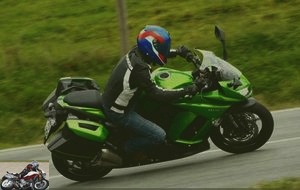
Motorway and expressways
Without having the old version in parallel, it is difficult to judge all the good of the engine upgrades. It grows hard, everywhere, all the time and more and more the closer you get to the red zone. The most surprising remains the way in which the heart of the Kawasaki distills its micro vibrations (because yes, it vibrates). Mounted almost completely rigid in the frame, we feel it live through the footrests, the tank, the handlebars. The sensation is very diffuse and contributes to the charm of the whole when you accelerate. At stabilized speed, the phenomenon is more noticeable, but the resonance often only passes through a single element of the frame and hardly disappears 200 turns later. Thus, we can end up with footrests massaging at 130 km / h, nothing at 133 and then have the mirrors which blur only at 151 km / h. The phenomenon is all the more strange in that not a single one of our testing machines “vibrated” in the same way. In terms of gearbox ratios, however, Kawasaki may have lengthened sixth gear, but we always instinctively seek a seventh gear as we have the impression that the engine is spinning a little too much on the highway. At 130 km / h, the tachometer shows however only 5,500 rpm, knowing that there are still 6,500 more before reaching the red zone. Perhaps this is the work a little too successful on the intake air box. A little peace of mind in the helmet wouldn’t have been luxury for very long stages. Especially since with an average fuel consumption hovering around 6 L / 100 km, this SX can consider stages of more than 300 km before refueling. Better, on the second day of our test by trying to titillate the ECO mode, the on-board computer announced a range of 400 km !

In terms of protection, nothing has changed, no more than honorable. The lower body is perfectly protected but the bubble leaves the shoulders too exposed. By playing on the three inclination settings of the bubble (you can change its inclination while riding with a little training) there is a way to improve things a little but the small gain in protection is then done to the detriment of quickly deafening aerodynamic noises without earplugs…. If my great moral probity, coupled with a local police force that straddles the rules, has held me back from attempting a Vmax. It was still possible to apprehend the stability in curves at high speed. On big compressions, the rear showed some signs of unhappiness with its original settings but regained its serenity after adding two turns of preload on the new wheel. Don’t act !

Departmental
Unsurprisingly, this Kawasaki loves rough roads. And no need to drive like crazy to appreciate the qualities of the engine and the chassis. Miss Z 1000 SX also agrees to stroll by winding on the couple. At a higher rate, the tendency of the front axle to lock when braking on the angle has disappeared but it is difficult to say if the credit goes to the new suspension settings or the Bridgestone Battlax S20 (the old one was fitted with BT-016, rather sporty ride). Still, the Kawasaki never seems to want to split up and turns in a single block with a front axle firmly planted on the ground entering the bend. Getting out is almost a formality with the rear end under traction control and you attack without a second thought. Well, by driving (really) beyond reason, the SX becomes physical in changing angles or tightening a trajectory, even with the help of the rear brake. Logically, improvising with a 230 kg machine requires hands or skill. But as long as the driver is at four-fifths of his ability, the SX can be taken to hell without making you sweat a drop. As for braking, the new monobloc calipers offer extra bite, but the difference is only really noticeable with the versions without ABS. According to a colleague who likes to wear snakeskin, all Kawasaki models equipped with ABS suffer from the same "defect", probably so as not to inadvertently trigger the system when braking too hard ….
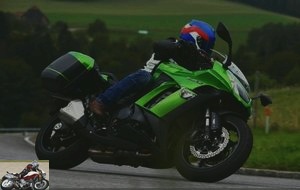
Duo
Although the space allocated to the rear end is limited, the passenger seat is relatively comfortable. When driving fast, the grips are not ideally placed to grip and you have to grab onto the rider to avoid accidental helmet hits. It works well on the motorway at constant speed, but the space available for the legs with the side cases may make long stages difficult in the long run..
Consumption
With a 19-liter tank and consumption that has varied between barely 6 liters per 100 km and more than 7 on the attack, the average range is around 300 km or even 400 km if we limit ourselves to the highway. . The future owners of Z 1000 SX 2014 are invited to leave their impressions on the opinions history to verify all the merits of the extension of the last report by Kawasaki.
Accessories
The Kawasaki accessories catalog is certainly not as extensive as at Ducati or KTM, but the Z 1000 SX is entitled to no less than 21 references. To improve its GT capabilities, the Greens offer large 39-liter side cases (€ 718), a comfort saddle (€ 417, highly recommended for long distance), heated grips (€ 201) or even a top case of 39 liters (500 €). On the cosmetic and protection side, you have the choice between a smoked screen, a passenger seat cowl, a support for self-powered GPS, protective pads or even a double racing exhaust from Akrapovic ….
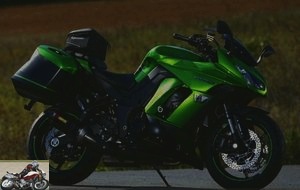
Conclusion
The registration numbers prove it, Kawasaki’s proposal for the Sport-GT segment was relevant in 2010 and will probably still be so with the 2014 vintage of the Z 1000 SX. If the improvements in the suspensions and engine are almost in detail, the driving aids are a real plus, providing a gain in performance as well as in safety. After that, you must not be mistaken about the goods. The Z 1000 SX is a perfect medium-haul, endowed with solid sporting potential and powered by an engine that is as powerful as it is pleasing. To cut down the kilometers in packs of 400, we can think about a Honda CBF 1000 F or, to stay in the family, a Versys 1000, just as efficient but less fun to take … Last good news, Kawasaki announces that its novelty should only cost a few hundred euros more than the current model, priced at € 12,499. The ABS will be charged € 600, the suitcase kit € 800 and the Topcase kit € 500. On the occasion of its marketing, a big launch party will be organized the second week of December in all Kawasaki dealerships in France.
Strong points
- motor
- cycle part
- electronics: KTRC…
Weak points
- duo
The technical sheet / comparo 2003/2007/2010
Related articles
-
Kawasaki Versys 1000 SE motorcycle test
3rd evolution for the shock road trail hybrid 4 cylinders in line, 1,043 cm3, 120 hp and 102 Nm, KECS electronic suspensions, 257 kg, 16,899 euros…
-
2012 Kawasaki ER-6f motorcycle test
Swiss army knife first price While the ER-6n has been a historic bestseller in the Kawasaki lineup since its debut in 2006, its streamlined “f” version…
-
4 cylinders in line, 948 cm3, 111 hp at 8,500 rpm, 10 m / kg at 6,500 rpm, 215 kilos, from € 11,999 A skillfully modified Z 900 or the worthy heir to the…
-
Kawasaki VN 1700 Voyager Custom ABS review
Kawa makes the clone …. With her very sleek lowered silhouette and plethora of equipment, this slanted-eyed American is largely inspired by the Harley…
-
Kawasaki ZX10R motorcycle test
The motorcycle division of the giant Kawasaki industry, is only a drop in the sea, but that does not prevent it from being a major player in the world of…
-
Kawasaki Z 750 motorcycle test
Cure of youth After a big success and more than 62,000 models sold, the Kawasaki Z750 evolves only 3 years later its output: engine, chassis and design….
-
Cruise missile The ultimate breed of sports cars, the Kawasaki ZZR 1400 is a living myth; the last witness to an almost vanished age when speed and power…
-
Kawasaki Versys 1000 S Grand tourer motorcycle test
Daily test for fifteen days 1,043 cm3, 120 hp at 9,000 rpm, 102 Nm at 7,500 rpm, 257 kg, 15,099 euros (17,099 euros Grand Tourer version) This bike, to…
-
Custom for all ! This Kawasaki hides its game well. Under its air of custom for young license, the Vulcan S is actually a fake roadster with a sparkling…
-
998 cm3, 210 hp at 13,000 rpm, 11.3 m / kg, 300 km / h, 206 kilos, € 17,799 Breathtaking performance, cutting-edge electronics, pure feel… You may not…
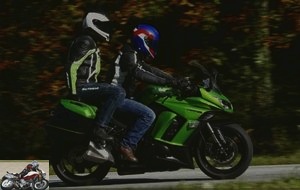
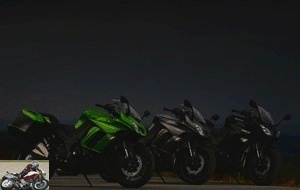
Dear Mr. Triumph, your 800 XCA, I don’t want it.
And yet I am a triumphist, and even a tigerist, and even a tiger800XCiste. I owned the 2011 800XC, the 2015 8000XC, which I sold to take over a 2011 one. I remember having a salesperson for the brand on the phone, who asked me why I had done such a thing, and I told him that his 2015 800XC, it was very nice to stroll on the boulevard, but that stuck in a muddy forest in Romania or whatever, it was not worth a tripette. Because a trail, dear Mr. Triumph, is not a Christmas tree covered with buttons and screens flashing everywhere, a trail is not a motorcycle with a tank of less than 20 liters, a trail it’s not a motorcycle that weighs 220 kilos.
So your XCA has 15,000 balls, you keep it, and I keep, for lack of better, my XC of 2011. That I will replace one day next with a good old Tenere or other, a real thing that takes you to the end of the world with a key of 10 and a candle in his pocket.